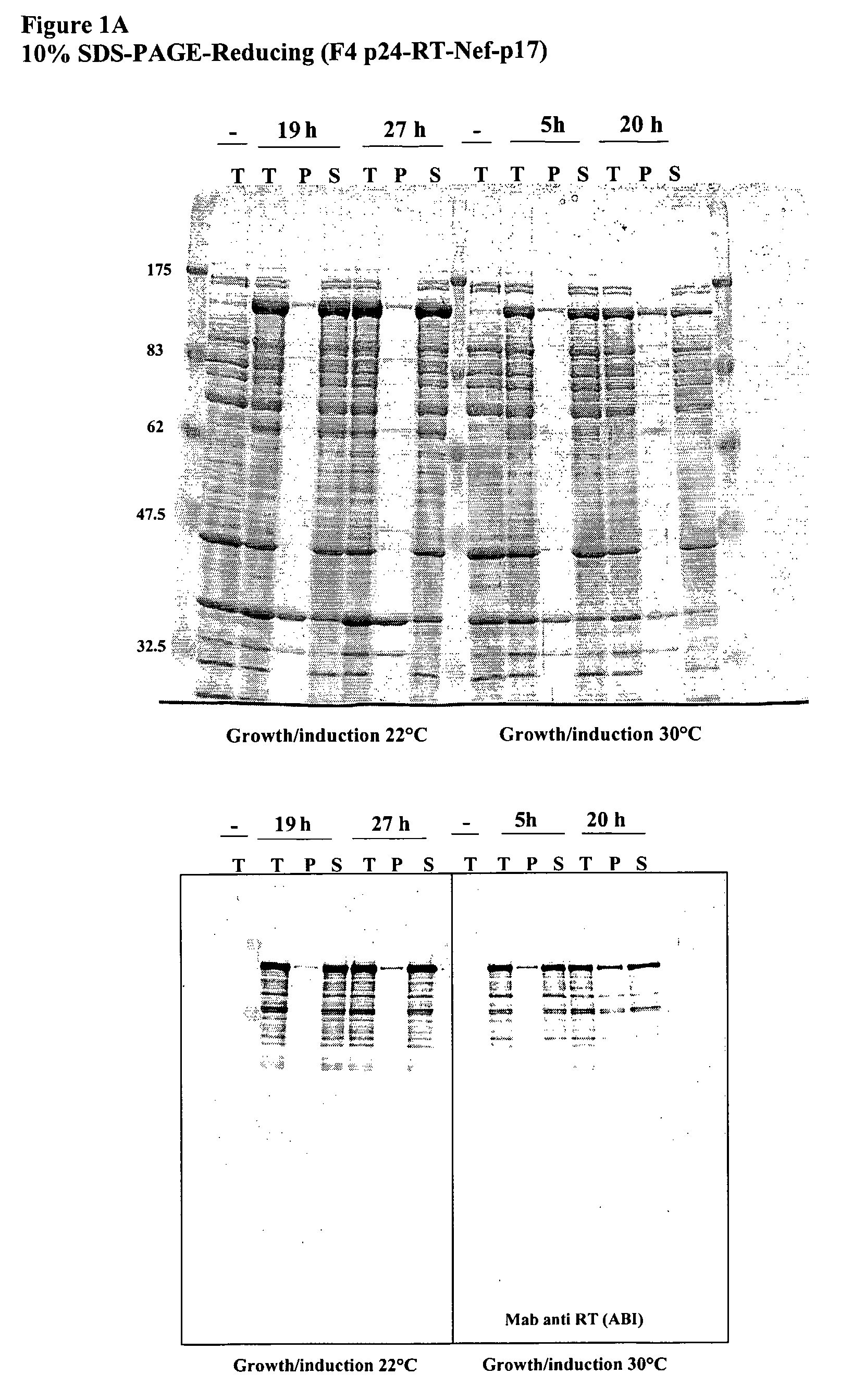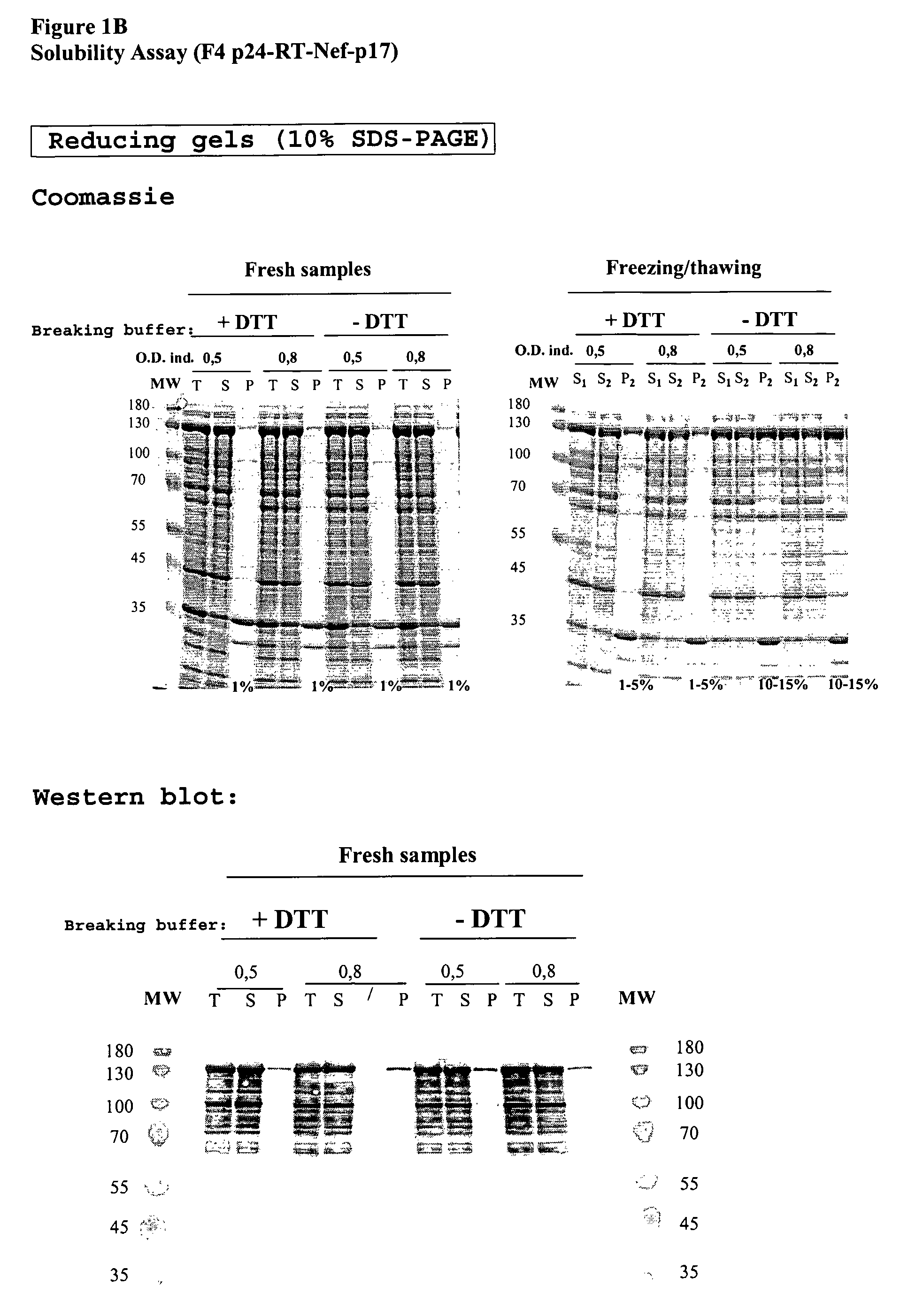Vaccine for prevention and treatment of HIV-infection
a technology for hiv infection and vaccines, applied in the field of new hiv polypeptide constructs, can solve the problems of difficult expression, difficulty in coding, and difficulty in producing fusion proteins
- Summary
- Abstract
- Description
- Claims
- Application Information
AI Technical Summary
Benefits of technology
Problems solved by technology
Method used
Image
Examples
example 1
Construction and Expression of HIV-1 p24-RT-Nef-p17 Fusion F4 and F4 Codon Optimized (co)
1. F4 Non-Codon-Optimised
[0139]HIV-1 gag p24 (capsid protein) and p17 (matrix protein), the reverse transcriptase and Nef proteins were expressed in E. coli B834 strain (B834 (DE3) is a methionine auxotroph parent of BL21 (DE3)), under the control of the bacteriophage T7 promoter (pET expression system).
[0140]They were expressed as a single fusion protein containing the complete sequence of the four proteins. Mature p24 coding sequence comes from HIV-1 BH10 molecular clone, mature p17 sequence and RT gene from HXB2 and Nef gene from the BRU isolate.
[0141]After induction, recombinant cells expressed significant levels of the p24-RT-Nef-p17 fusion that amounted to 10% of total protein.
[0142]When cells were grown and induced at 22° C., the p24-RT-Nef-p17 fusion protein was confined mainly to the soluble fraction of bacterial lysates (even after freezing / thawing). When grown at 30° C., around 30% of...
example 2
Construction and Expression of P51 RT (Truncated, Codon-Optimised RT)
[0186]The RT / p66 region between amino acids 428-448 is susceptible to E. coli proteases. The P51 construct terminates at Leu 427 resulting in the elimination of RNaseH domain (see RT sequence alignment in FIG. 3).
[0187]The putative E. coli “frameshift” sequences identified in RT native gene sequence were also eliminated (by codon-optimization of p51 gene).
p51 Synthetic Gene Design / Construction:
[0188]The sequence of the synthetic p51 gene was designed according to E. coli codon usage. Thus it was codon optimized such that the codon usage resembles the codon usage in a highly expressed gene in E. coli. The synthetic gene was constructed as follows: 32 oligonucleotides were assembled in a single-step PCR. In a second PCR the full-length assembly was amplified using the ends primers and the resulting PCR product was cloned into pGEM-T intermediate plasmid. After correction of point errors introduced during gene synthes...
example 3
Construction and Expression of p17-Nef and Nef-p17 with or without Linker
[0205]The double fusion proteins were constructed with and without linkers. The linkers aimed to decrease potential interactions between the two fusion partners and are as follows:
[0206]
Recombinant Plasmids Construction:
[0207]pET29a / Nef-p17 Expression Vector:[0208]Nef-p17 fusion gene was amplified by PCR from the F4 recombinant plasmid. The PCR product was cloned into the intermediate pGEM-T cloning vector and subsequently into the pET29a expression vector.
[0209]pET28b / p17-Nef Expression Vector:[0210]Nef gene was amplified by PCR from the F4 recombinant plasmid. The PCR product was cloned into the intermediate pGEM-T cloning vector and subsequently into the pET28b / p17 expression vector, as a C-terminal in frame fusion with the p17 gene.
[0211]pET29a / Nef-Linker-p17 and pET28b / p17-Linker-Nef Expression Vector:[0212]A 18 bp DNA fragment coding for the hexapeptide linker (GSGGGP; SEQ ID NO:20) was inserted between N...
PUM
| Property | Measurement | Unit |
|---|---|---|
| diameter | aaaaa | aaaaa |
| molecular mass | aaaaa | aaaaa |
| molecular mass | aaaaa | aaaaa |
Abstract
Description
Claims
Application Information
 Login to View More
Login to View More - R&D
- Intellectual Property
- Life Sciences
- Materials
- Tech Scout
- Unparalleled Data Quality
- Higher Quality Content
- 60% Fewer Hallucinations
Browse by: Latest US Patents, China's latest patents, Technical Efficacy Thesaurus, Application Domain, Technology Topic, Popular Technical Reports.
© 2025 PatSnap. All rights reserved.Legal|Privacy policy|Modern Slavery Act Transparency Statement|Sitemap|About US| Contact US: help@patsnap.com



